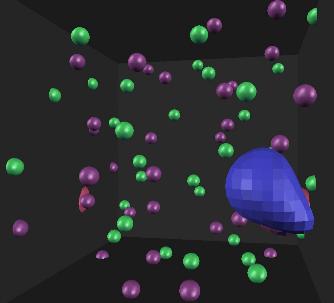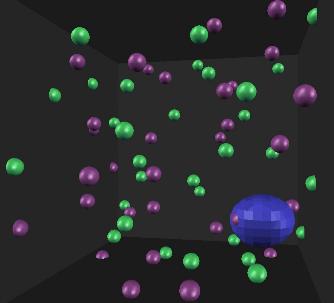Daniel Montemayor, Tomas Castonguay, and David Coker Department of Chemistry, Boston University
Serena Causo, and Giovanni Ciccotti Department of Physics, University of Rome “La Sapienza”




Significance
Our calculations explore the liquid phase of metal-molten salt solutions to develop an understanding of how the excess electrons diffuse in these liquids. There is a purely classical ion motion component to the electron diffusion that is analogous to the motion of a “bubble” in a liquid, the bubble moves because the liquid atoms move. But there are also fundamentally quantum mechanical components to the motion of excess electrons. Unlike a classical bubble, an electron can quantum mechanically tunnel between localization sites and can thus diffuse faster than the collective motion of a simple void space. The electron can also be excited as it moves through the liquid and this excitation affects its diffusive motion. Our calculations approximately include both these quantum effects.
The images show instantaneous snapshots of contour surfaces of the excess electron density in a liquid mixture sample of potassium and potassium chloride represented using 32 K+ ions and 31 Cl- ions with periodic boundary conditions. The various images show different excited states of the electron in an instantaneous configuration of ions at a point along a typical trajectory of this system. Some excited states have density localized in different regions of the fluid to the ground state. Other excited states have density localized in the same region as the ground state. These excited states must have nodes in their wave functions to be orthogonal to the ground state so we color the density contours red or blue to represent the wave function phase.
These calculations were performed using adiabatic ground state dynamics in which the ions move under the influence of forces from only the ground state density. Such calculations can approximately include the influence of quantum tunneling but ignore electronic excitation. Our estimate of the adiabatic diffusion constant from the mean square displacement of the electron as a function of time is Dad = 2.17×10-3 cm2s-1 which is about 30% smaller than diffusion constant measured in experiments, Dexpt = 3×10-3 cm2s-1. This difference is probably due to the neglect of excitation in our adiabatic ground state calculations and this approximation is currently being lifted in new calculations of the velocity auto-correlation function of the excess electron using a new excited state approach. For comparison the ion diffusion constant in these materials is 10-5 cm2s-1 i.e. the excess electron moves about 100 times faster than the ions in these liquids.
Support and Acknowledgements
This work was supported by the NSF, grant number CHE-0316856 and the American Chemical Society, grant number 39180-AC6. This work grew out of Coker’s Sabbatical in Rome which was supported by the Italian National Institute for the Physics of Matter (INFM). Coker acknowledges the hospitality of the Physics Department of the University of Rome during his Sabbatical visit. Graphics programming by Erik Brisson, Scientific Computing and Visualization, Boston University.
